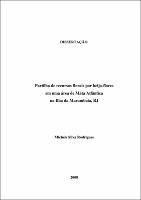Please use this identifier to cite or link to this item:
https://rima110.im.ufrrj.br:8080/jspui/handle/20.500.14407/10595| metadata.dc.type: | Dissertação |
| Title: | Partilha de recursos florais por beija-flores em uma área de Mata Atlântica na Ilha da Marambaia, RJ |
| Other Titles: | Resources’ sharing by hummingbirds in an area of rainforest on the Ilha da Marambaia, RJ |
| metadata.dc.creator: | Rodrigues, Michele Silva |
| metadata.dc.contributor.advisor1: | Piratelli, Augusto João |
| metadata.dc.contributor.referee1: | Ferreira, Ildemar |
| metadata.dc.contributor.referee2: | Koch, Ingrid |
| metadata.dc.contributor.referee3: | Braz, Denise Monte |
| metadata.dc.description.resumo: | Os beija-flores (Aves, Trochilidae) representam um grupo importante nas interações entre aves e flores, sendo, dentre as aves nectarívoras, as mais especializadas, polinizando diversas plantas. Estratégias variadas permitem que organismos com sobreposição de nichos consigam partilhar recursos. O presente estudo teve como objetivo investigar a partição de recursos alimentares entre espécies de beija-flores na Ilha da Marambaia, RJ, determinando seu comportamento e seu papel na polinização das plantas estudadas. As espécies Erythrina speciosa Andrews, Malvaviscus arboreus Cav., Pseudananas sagenarius (Arruda) Camargo, Sophora tomentosa L. e Vriesea neoglutinosa Mez foram observadas pelo método indivíduo focal por um período regular de 30 minutos a cada hora, quando registraram-se as espécies de beija-flor visitantes, o horário e a duração de cada visita, o número de flores visitadas e o modo do visitante explorar a flor. Os beija-flores foram classificados em visitantes legítimos e ilegítimos e tiveram seu modo de forrageamento (territorialista ou rotas de captura) determinado. Foram também registradas as interações agonísticas intra e interespecíficas. A viabilidade do pólen foi testada e a concentração de açúcares no néctar medida no campo. Foram registradas seis espécies de beija-flores visitando as flores: Amazilia fimbriata, Amazilia versicolor, Chlorostilbon lucidus, Eupetomena macroura, Florisuga fusca e Thalurania glaucopis, ocorrendo 51 interações agonísticas. Dentre estas espécies T.glaucopis foi a mais freqüente (47,72%), sendo observada visitando flores de todas as espécies de plantas estudadas. As visitas legítimas foram predominantes e o número de espécies de beijaflores visitantes variou entre as espécies de plantas. Erythrina speciosa e S. tomentosa foram visitadas por quatro espécies cada uma, enquanto M. arboreus, P. sagenarius e V. neoglutinosa por três espécies cada. A taxa de visitação por beija-flores por unidade de tempo também variou entre as espécies de plantas, sendo em E. speciosa 1,18 visitas/h, em V. neoglutinosa 0,7 visitas/h, em S. Tomentosa 0,5 visitas/h, em M. arboreus 0,4 visitas/h e em P. sagenarius 0,3 visitas/h. Algumas espécies inibem a visita de outras, visitam as flores no período da manhã e outros no período da tarde, assim, partilham recursos em horário diferentes para diminuir a competição. |
| Abstract: | Hummingbirds (Aves, Trochilidae) are a very important group in bird-flower interactions, being the most specialized nectarivorous bird and pollinating many plant species. Several strategies allow organisms having niche overlapping share resources, and this study has as objectives to investigate the partition of food resources among hummingbird species in the Marambaia Island, RJ, determining their behaviour and their role on the pollination of the studied plant species. Erythrina speciosa Andrews, Malvaviscus arboreus Cav., Pseudananas sagenarius (Arruda) Camargo, Sophora tomentosa L. and Vriesea neoglutinosa Mez was observed by the individual-focal method for a regular period of 30 minutes each hour, when the visiting species, time and duration of each visit, number of visited flowers and behavior were determined. Hummingbirds were classified as legitimate and illegitimate visitors, and their foraging strategies (territorialists x trapliners) were identified. Intra and interspecific agonistic interactions were also registered. Pollen viability was tested and nectar sugar concentration was measured in the field. Six hummingbird species were observed visiting the studied flowers: Amazilia fimbriata, Amazilia versicolor, Chlorostilbon lucidus, Eupetomena macroura, Florisuga fusca and Thalurania glaucopis, and 51 agonistc interactions were detected. Thalunaria glaucopis was the most frequent species (47.72%), being observed visiting flowers of all the studied plants. The legitimate visits werw predominant and the number of hummingbird species varied among the plant species. Erythrina speciosa and S. tomentosa were visited by four species each one, while M. arboreus, P. sagenarius and V. neoglutinosa by three species each. Rates of visitation by unit of time have also varied among plant species, being 1.18 visits/hour in E. speciosa, 0.7 in S. Tomentosa, 0.5 in M. arboreus and 0.3 in P. sagenarius. Some species inhibit the visit of others, visiting the flowers in the morning and others in the afternoon, thus sharing resources in different time to reduce the competition |
| Keywords: | beija-flores Mata Atlântica polinização recursos alimentares hummingbirds Atlantic Rainforest pollination resources food |
| metadata.dc.subject.cnpq: | Biologia Geral |
| metadata.dc.language: | por |
| metadata.dc.publisher.country: | Brasil |
| Publisher: | Universidade Federal Rural do Rio de Janeiro |
| metadata.dc.publisher.initials: | UFRRJ |
| metadata.dc.publisher.department: | Instituto de Ciências Biológicas e da Saúde |
| metadata.dc.publisher.program: | Programa de Pós-Graduação em Biologia Animal |
| Citation: | RODRIGUES, Michele Silva. Partilha de recursos florais por beija-flores em uma área de Mata Atlântica na Ilha da Marambaia, RJ. 2008. 48 f. Dissertação (Mestrado em Biologia Animal) - Instituto de Ciências Biológicas e da Saúde, Universidade Federal Rural do Rio de Janeiro, Seropédica-RJ, 2008.6 |
| metadata.dc.rights: | Acesso Aberto |
| URI: | https://rima.ufrrj.br/jspui/handle/20.500.14407/10595 |
| Issue Date: | 27-Jun-2008 |
| Appears in Collections: | Mestrado em Biologia Animal |
Se for cadastrado no RIMA, poderá receber informações por email.
Se ainda não tem uma conta, cadastre-se aqui!
Files in This Item:
| File | Description | Size | Format | |
|---|---|---|---|---|
| 2008 - Michele Silva Rodrigues.pdf | Michele Silva Rodrigues | 6.83 MB | Adobe PDF |  View/Open |
Items in DSpace are protected by copyright, with all rights reserved, unless otherwise indicated.

